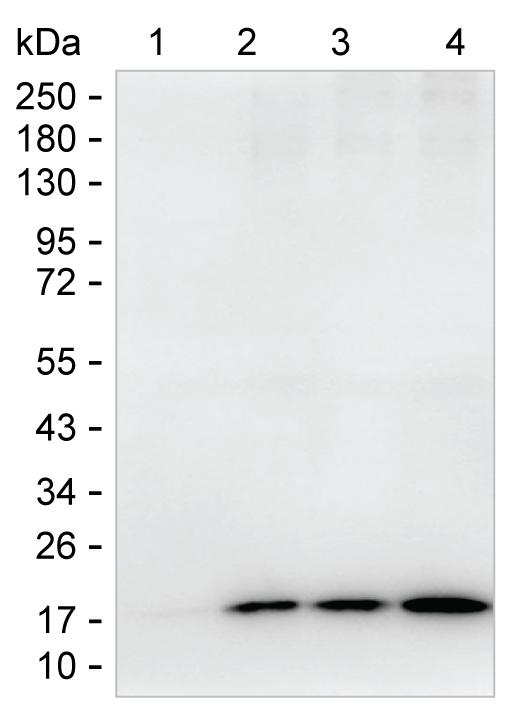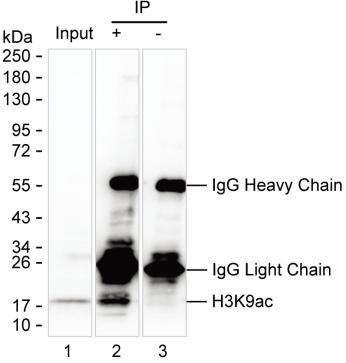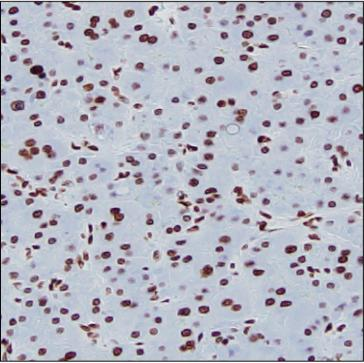



| WB | 咨询技术 | Human,Mouse,Rat |
| IF | 1/100-1/200 | Human,Mouse,Rat |
| IHC | 1/500 | Human,Mouse,Rat |
| ICC | 技术咨询 | Human,Mouse,Rat |
| FCM | 咨询技术 | Human,Mouse,Rat |
| Elisa | 咨询技术 | Human,Mouse,Rat |
| Host/Isotype | Rat IgG1 |
| Antibody Type | Primary antibody |
| Storage | Store at 4°C short term. Aliquot and store at -20°C long term. Avoid freeze/thaw cycles. |
| Species Reactivity | Human |
| Immunogen | Purified recombinant fragment of human Histone H3K9ac |
| Formulation | Purified antibody in PBS with 0.05% sodium azide |
+ +
以下是关于Histone H3K9ac抗体的3篇参考文献的简要信息:
---
1. **文献名称**:**"Histone acetylation and transcriptional regulatory mechanisms"**
**作者**:Schübeler, D. et al.
**摘要**:该研究通过染色质免疫沉淀(ChIP)和测序技术,揭示了H3K9ac在基因启动子区域的富集与基因转录激活的关联,证明H3K9ac抗体在表观遗传调控研究中的关键作用。
2. **文献名称**:**"Role of histone H3 lysine 9 acetylation in leukemia differentiation and therapy response"**
**作者**:Wang, Z. et al.
**摘要**:利用H3K9ac抗体进行免疫印迹和ChIP分析,发现急性白血病细胞中H3K9ac水平异常升高,靶向调控该修饰可恢复分化能力并增强化疗敏感性。
3. **文献名称**:**"H3K9ac facilitates pluripotency gene activation during early reprogramming"**
**作者**:Whyte, W.A. et al.
**摘要**:通过单细胞ChIP-seq结合H3K9ac抗体,阐明该修饰在多能干细胞重编程早期阶段促进核心多能性基因(如Oct4、Nanog)的快速激活。
4. **文献名称**:**"Dynamic H3K9ac modification regulates fear extinction memory in the amygdala"**
**作者**:Sun, H. et al.
**摘要**:在小鼠恐惧条件反射模型中,使用H3K9ac抗体分析杏仁核神经元染色质状态,发现该修饰的动态变化与恐惧消退记忆的巩固密切相关。
---
以上文献均通过H3K9ac抗体探究其在不同生物学背景(如转录调控、疾病机制、神经可塑性)中的功能,涵盖实验方法如ChIP-seq、免疫印迹等。
Histone H3K9ac (acetylated lysine 9 on histone H3) is a post-translational modification associated with active gene transcription. Acetylation at this site neutralizes the positive charge of lysine, reducing its affinity for the negatively charged DNA backbone. This relaxes chromatin structure, facilitating access for transcriptional machinery and promoting gene expression. The H3K9ac modification is enriched at promoters and enhancers of actively transcribed genes, making it a key epigenetic marker for studying transcriptional regulation.
Antibodies targeting H3K9ac are critical tools in epigenetics research. They are widely used in techniques like chromatin immunoprecipitation (ChIP-seq) to map acetylation patterns genome-wide, as well as in immunoblotting and immunofluorescence to assess spatial and temporal dynamics of chromatin states. These antibodies help investigate how environmental cues, cellular differentiation, or disease states alter epigenetic landscapes. For instance, aberrant H3K9ac levels have been linked to cancer, neurological disorders, and metabolic diseases, underscoring its biological relevance.
Validation of H3K9ac-specific antibodies is essential, as cross-reactivity with other acetylated histone residues (e.g., H3K14ac) could compromise data interpretation. Rigorous testing using knockout models, peptide competition assays, and mass spectrometry is typically required. Commercially available H3K9ac antibodies are often generated using synthetic acetylated peptides as immunogens, with host species (e.g., rabbit, mouse) and clonality (monoclonal/polyclonal) varying by supplier. Their applications span basic research in chromatin biology to translational studies exploring epigenetic therapies.
×